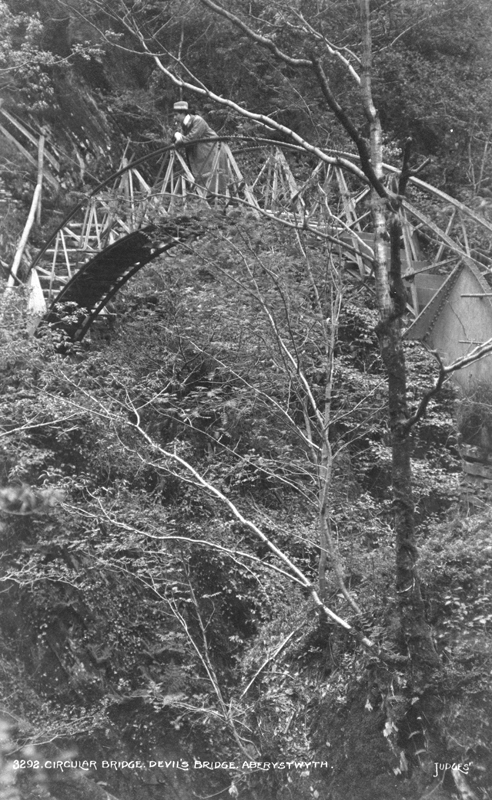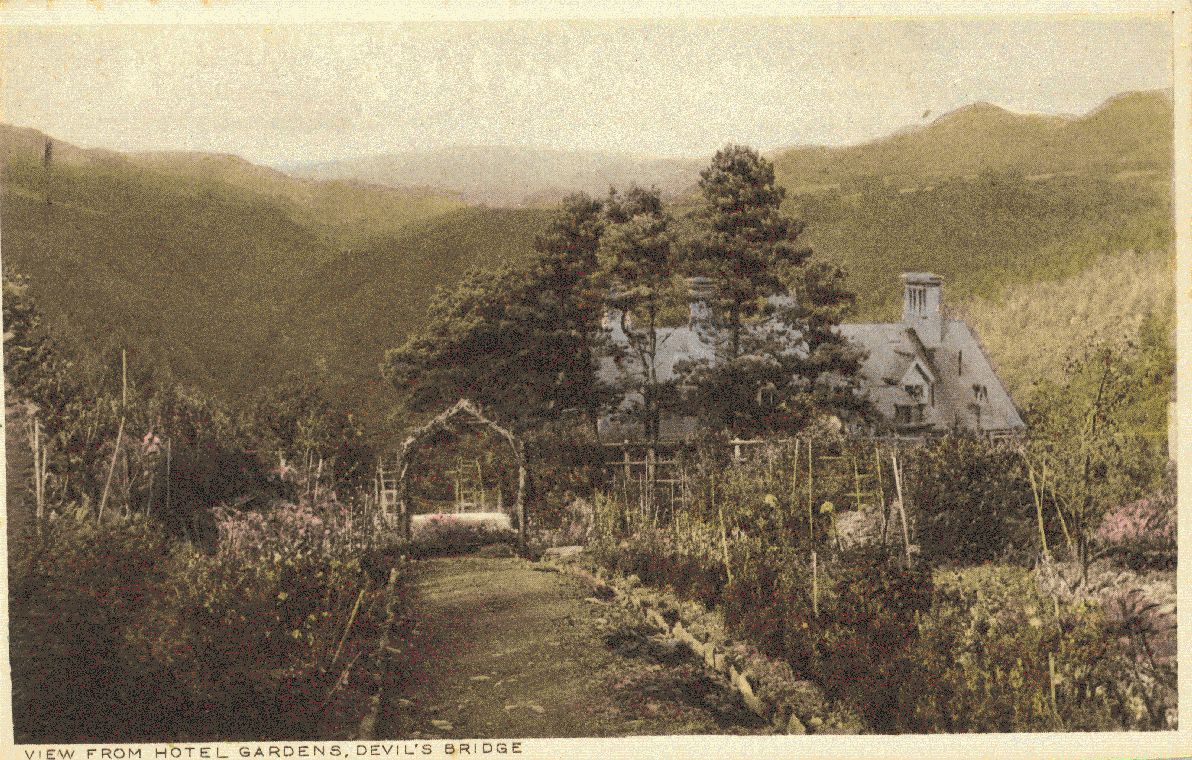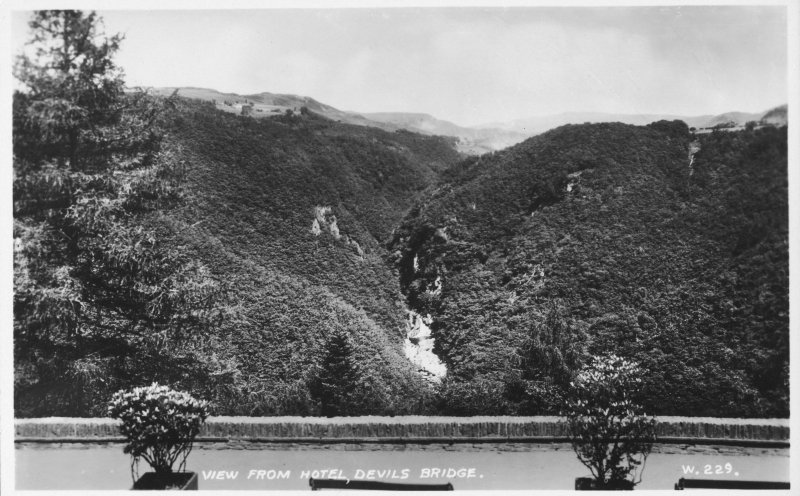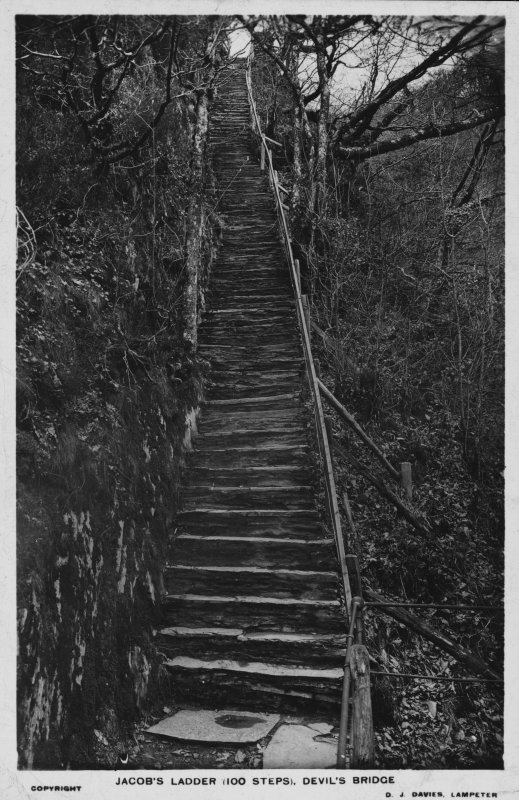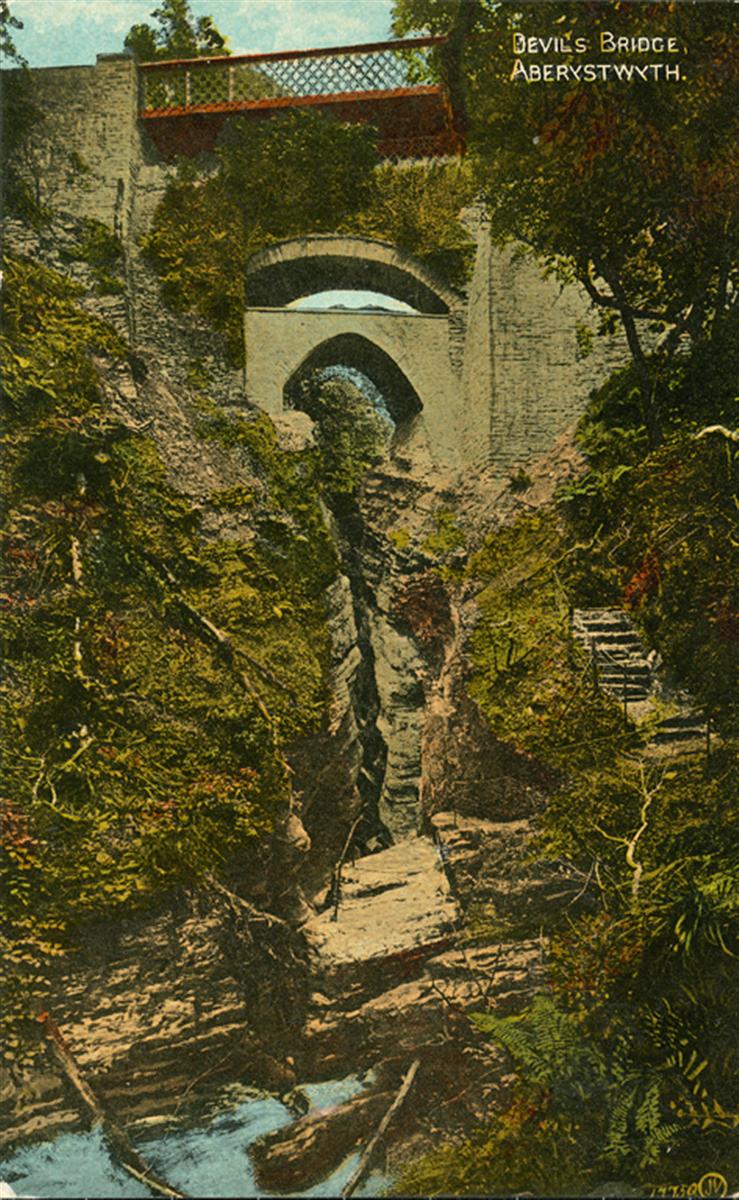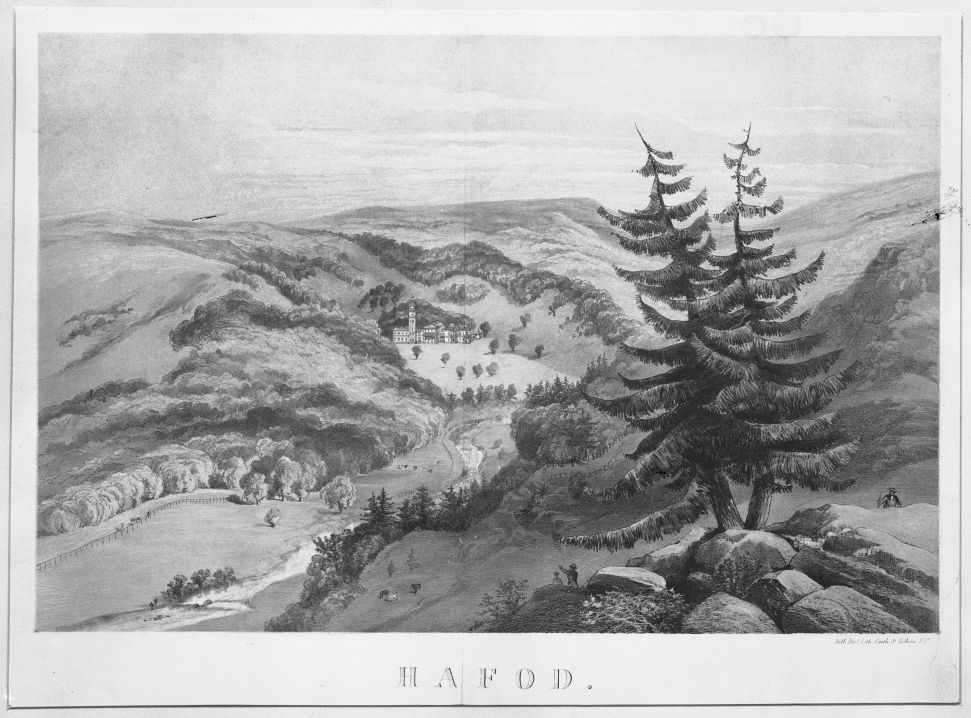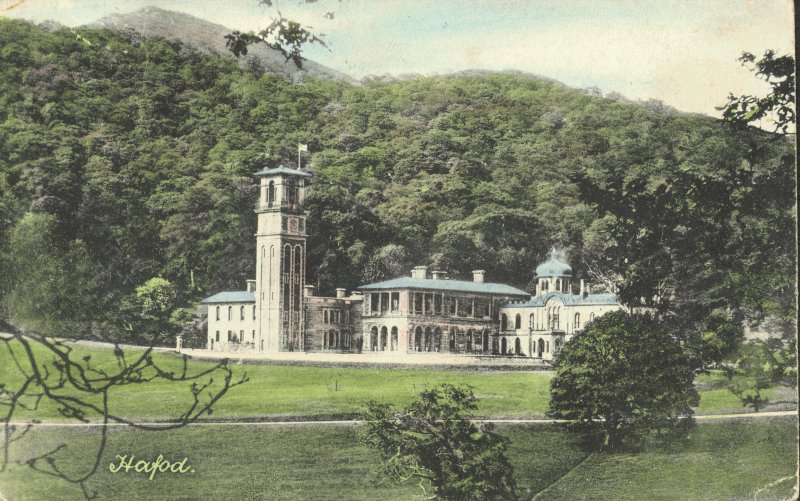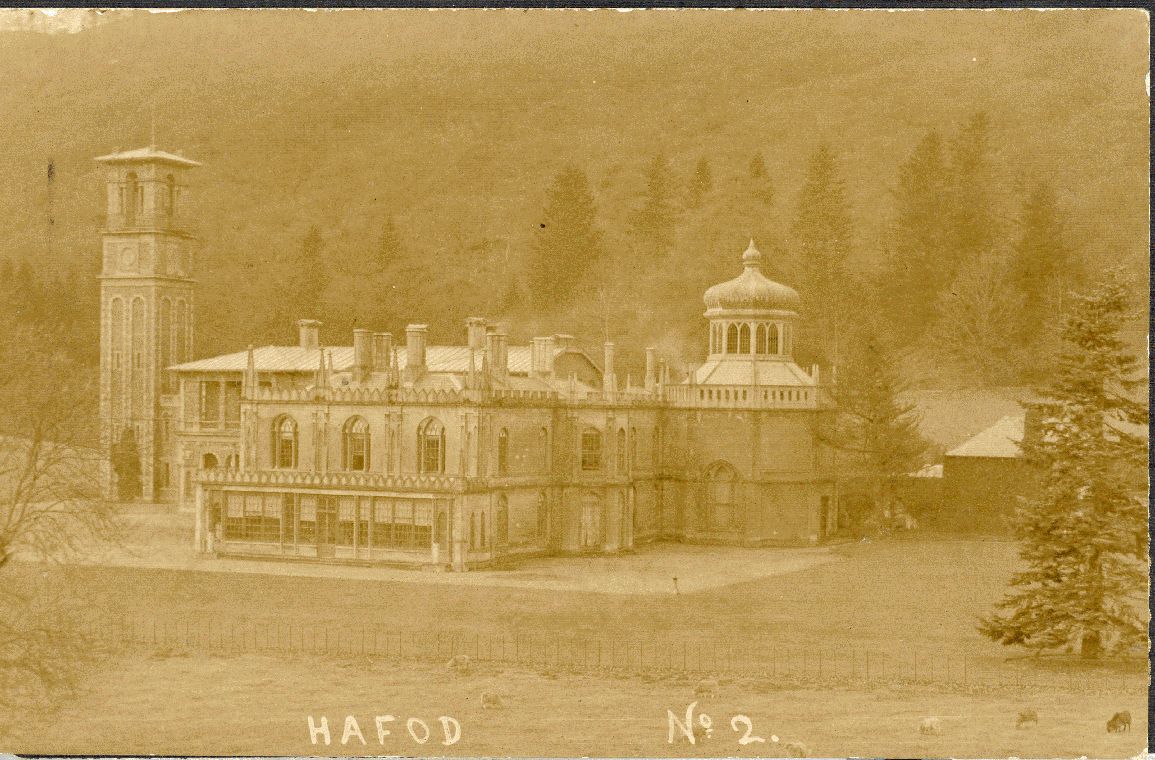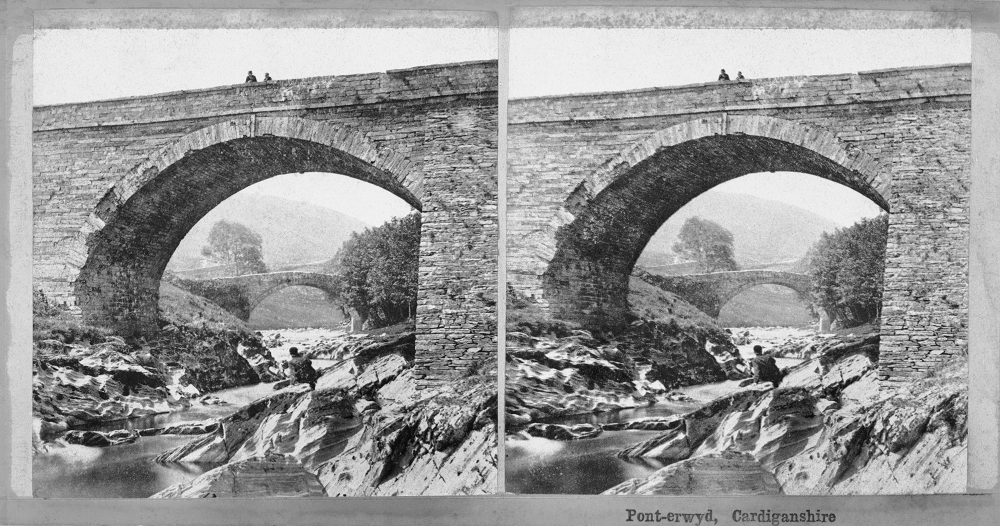Devil’s Bridge and Hafod Arms Hotel - Overview
This small village with its picturesque waterfall takes its name from the bottom-most of three bridges over the river Mynach which were incrementally built on top of each other. Local legend has it that the Devil built this bridge in a single night, having entered into a bet with an old woman whose valuable cow was stranded on the opposite bank of the river. As payment for the return of her animal, she had to promise the Devil the first living soul to cross the bridge. However, the woman tricked him by throwing a loaf of bread over the bridge, allowing her dog run after it. The Devil was so ashamed that he never showed his face again – or so the story goes.
This first bridge, small and stone built, is almost certainly medieval in date, possibly built by the monks of the nearby Cistercian monastery, Strata Florida. The second bridge was built over this in 1753, altered with iron parapets in 1814. The third and final one followed in 1901, being a metal lattice bridge which carries the modern road. Each time, the road was widened, levelled out and improved, thus reflecting the gradual improvement of infrastructure in Ceredigion over the course of the past centuries.
Historically, the bridge lay on the main road between Llangurig and Aberystwyth, thus giving tourists prime access to the waterfalls and famous ‘Devil’s Punchbowl’. Tourists looking for picturesque Welsh landscapes flocked here in increasing numbers towards the end of the eighteenth century. As a result, the owner of the surrounding land, Thomas Johnes, built a hunting lodge by the roadside in 1787. In 1839, the lodge was converted by its new owner, Sir Henry Houghton, and reopened as the Hafod Arms Hotel, named after the nearby estate, Hafod Uchdryd.
A few years after the hotel opened its doors, Carl Carus and Friedrich August II, King of Saxony, stopped here during their rain-soaked coach journey from Brecon to Aberystwyth. Having dried their travel-weary bones by the side of a roaring fire in the lounge, they set out and explored the picturesque chasm below the bridges. Today, tourists need no longer rely on shaking and wet post coaches. Instead, they can enjoy a ride to the bridges and waterfall on the narrow-gauge Vale of Rheidol Railway from Aberystwyth which opened in 1902.
Accounts of Travel
England und Schottland im Jahre 1844, 1844
Carl Gustav Carus (1789 – 1869)
Kaum hatte man sich an einem Caminfeuer halb getrocknet, so wich der Nebel etwas auseinander, man ergriff die Schirme und besuchte im noch fortträufelnden Regen den Wasserfall. Zuerst von einer vorspringenden Felsenecke sieht man die weißschäumende Gebirgsader zwischen grünen Wänden tief und tiefer hinabstürzen, dann nahe dieser Teufelsbrücke selbst klettert man am schlüpfrigen Felsen hinab, und sieht einen dieser Fälle in der Nähe – in Wahrheit ein prächtiges Landschafts-Studium darbietend mit seinen klaren Wellen, seinen schöngebrochnen Felsen und seiner anmuthigen Belaubung.
As soon as we had almost dried off by a fireside, the fog parted slightly and we took hold of our umbrellas and visited the waterfall while the drizzle continued. The white, foaming watery vein of the mountain comes into sight from a jutting cliff edge as it tumbles down deeper and deeper between green walls. Then near the Devil’s Bridge itself, you have to climb down the slippery rocks to see one of the falls up close. In truth, with its clear water, the pleasantly cracked rock and the handsome foliage, the fall provides a magnificent study of landscape.
(The King of Saxony’s Journey Through England and Scotland in the Year 1844. Trans. S.C Davison. London: Chapman and Hall, 1846)
"Auszüge aus reisebeschreibenden Briefen des vorletzten Grafen von Purgstall", 1796
Gottfried Wenzel von Purgstall (1773 – 1812)
Man trifft ein gutes reinliches Wirtshaus an, in dem man sehr bequemes Nachtlager findet. Ich rathe jedem, daß er eine Nacht dort bleibt, um dieser Entfernung von der Welt recht froh zu werden. Auch hat man mehr als einen Tag nöthig, um den nah gelegenen Landsitz des Colonel Johns (Havod) und die Teufesbrücke, und was dazu gehört, zu besehen. Ich freute mich, als ich ermüdet vom Reiten in das Wirtshaus kam, und mir die Wirthin ein so niedliches Parlour anwies mit einer confortablen Aussicht. ...
Den andern Morgen besah ich die Brücke. Eine alte Sage erzählt, sie sey vom Teufel gebauet, weil man nicht bestimmt angeben kann, von wem sie gebaut ist. Man hat über die alte eine andere neue gebauet, weil die erste tiefer ist, als die beyden Stücke Landes sind, die sie verbindet, und es also für die Wagen sehr unbequem und gefährlich war, über eine Brücke, die ungefähr so:

gestaltet ist, zu fahren; daher sieht das Ganze nun so aus:

Man versäume nicht links bey der Brücke hinabzuklettern, um einen kleinen Wasserfall zu sehen. Man ist ganz wie in Felsen eingeschlossen, und wenn man plötzlich den steilen Weg, den man herabkam, aufwärts ansieht, so wird einem für’s Hinaufkommen bange. Doch ist beym Hinanklimmen, vorausgesetzt daß man einen Wegweiser mit sich nehme, nicht die geringste Gefahr verbunden.
The traveller finds a good, clean guesthouse here in which he will have a comfortable night’s lodgings. I advise everyone to spend a night there in order to enjoy its remoteness from the world. Besides, it takes more than a day to see Hafod, Colonel Jones’s nearby country seat, and the Devil’s Bridge and everything that belongs to it. I was delighted when I returned to the guesthouse after a tiring ride and the landlady allocated me such a sweet parlour with a comfortable prospect. ...
The following morning I inspected the bridge. An old legend says it was built by the devil because it is not entirely possible to say who built it really. A new bridge has been built over the old one, because the original one is situated lower than the ground with which it connects on both ends. Thus it was very uncomfortable and dangerous for carriages to cross over a bridge that looked something like this:

Therefore the whole thing now looks like this:

Itinéraire descriptif et historique de la Grande Bretagne, c. 1850s
Alphonse Esquiros (1812 – 1876)
Le touriste arrive ainsi à l’hôtel de Havod Arms, qui domine un des plus beaux points de vue que l’on puisse imaginer: d’une hauteur de 100 mèt., il découvre en quelque sorte la vallée feuillue de la Rheidol et la rivière du même non, remplissant l’air du rugissement de ses eaux.
Le meilleur moyen pour contempler cette grande scène de la nature, c’est de passer le pont bâti sur le gouffre, et, prenant ensuite un sentier à dr., de descendre jusqu’au bord de l’eau. C’est un chemin rapide, un sentier qui se précipite traîtreusement entre les rochers, à une profondeur d’une trentaine de mètres. De ce point on découvre bien le caractère du hiatus pittoresque sur lequel le pont a été jeté. Sous son arche, la gorge se réduit à une simple fissure à peu près de la grosseur d’un homme. Le torrent, en descendant vers cette fente, bondit et bout en quelque sorte au milieu des durs rochers. A l’aide des pierres qu’il voiture dans sa chute, il a découpé les bords de son lit en échancrures, qui ont été comparées à autant de chaudrons. La déchirure originelle doit avoir été formée par quelque grande convulsion de la nature; car, dans l’état présent des choses, la force seule des eaux serait incapable de produire rien de semblable. Les dentelures des roches violemment séparées paraissent d’ailleurs correspondre entre elles d’une rive à l’autre. Dans le temps des pluies, quand l’étroit canal se trouve rempli, la rivière présente un spectacle magnifique; elle tombe, parmi les rochers et le feuillage, avec des bonds de 10, 20, 30, et même 35 mèt., de hauteur.
So the tourist arrives at the Havod Arms Hotel, that towers above one of the most beautiful views imaginable: from a height of 100 metres the tourist may discover the leafy Rheidol valley and the river of the same name that fills the air with the roaring of its waters.
The best way to contemplate this grand scene of nature is to cross the bridge built over the chasm, and, then taking a path to the right, to go down as far as the water’s edge. It is a quick way, a path that rushes treacherously between the rocks, at a depth of thirty metres or so. From here the character of the picturesque split over which the bridge was built can be well appreciated. Beneath its arch the gorge is reduced to a mere fissure roughly the size of a man. The torrent, flowing towards this slit, seems to jump and boil among the hard rocks. With the help of stones that it carries in its fall, the torrent has cut into the sides of its bed some deep indentations that have been compared to so many cauldrons. The original split must have been formed by some great convulsion of nature; because, in the present state of affairs, the power of the water alone would not have been capable of producing anything of the kind. The jagged outline of the rocks violently separated seem in fact to correspond to each other on either bank. In times of rain, when the narrow canal is full, the river makes a magnificent spectacle; it falls, among the rocks and foliage, leaping from heights of 10, 20, 30 and even 35 metres.
Voyage pittoresque dans le midi et le nord du pays de Galles, c. 1790s
Amélie de Suffren (1765 – 1817)
Il faut donc s’arrêter au Pont du Diable, qui n’offre rien cependant qui ne soit à la portée des facultés humaines. L’arche que l’on voit placée plus inférieurement, fut construite, à ce que l’on croit, sous le règne de Guillaume II, en 1087, par les moines de la Strata Florida, abbaye dont il reste encore des traces à dix milles environ, dans la vallée de Rheidol : ce pont fut jeté au-dessus d’un précipice de trente pieds de largeur et de 322 pieds de profondeur. Le second pont, placé au-dessus du premier, date de 1753, et ne peut donner aucune idée des progrès de l’architecture : elle est tellement environnée d’arbres, que l’observateur superficiel, où le voyageur indifférent, peut passer dessus sans se douter du précipice effroyable qu’il franchit, et au travers duquel le torrent appelé Mynach s’élance au milieu des abymes et tombe en cataractes. Des masses d’ardoises, unies et glissantes, rendent très-dangereuse l’approche de ce gouffre.
Ce paysage sublime est composé d’une chaîne de monts entassés qui semblent unir le ciel à la terre. Le mugissement des torrens dont les eaux jaillissent de toutes parts, interrompt seul le silence de ce lieu sauvage, où la nature a déployé sa terrifique grandeur. Trois cascades principales viennent se précipiter dans la rivière Rheidol, qui se creuse un lit étroit et raboteux dans le fond d’une profonde vallée.
So you must stop at the Devil’s Bridge, though it offers nothing beyond the realms of human capability. The lowest arch that can be seen was constructed, it is thought, during the reign of William II in 1087, by the monks of Strata Florida, an abbey whose ruins lie some ten miles away, in the Rheidol valley: this bridge was built over a chasm thirty feet wide and 322 feet deep. The second bridge, placed above the first one, dates from 1753, and cannot give any idea of the progress made by architecture: it is so surrounded by trees that the superficial observer, or the indifferent traveller, can cross it without noticing the horrifying chasm that he is surmounting, and through which the torrent named Mynach rushes in the depths and falls in cataracts. Masses of slate, smooth and slippery, make the approach to this chasm very dangerous.
This sublime landscape is composed of a range of mountains piled up, that seem to unite the sky with the land. The roar of the torrents, whose waters gush forth from all directions, is the only thing that disturbs the silence of this wild place, where nature has made a display of her terrifying grandeur. Three main waterfalls hurl themselves into the river Rheidol, which carves out a narrow and uneven bed for itself at the bottom of a deep valley.
